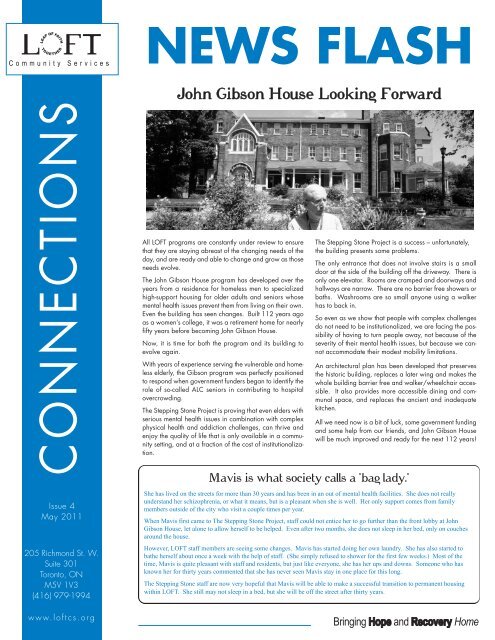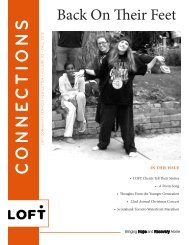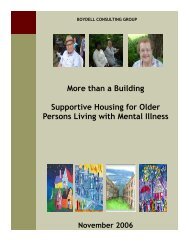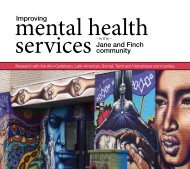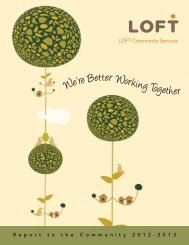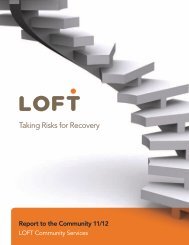May 2011 â John Gibson House Looking Forward - LOFT ...
May 2011 â John Gibson House Looking Forward - LOFT ...
May 2011 â John Gibson House Looking Forward - LOFT ...
- No tags were found...
Create successful ePaper yourself
Turn your PDF publications into a flip-book with our unique Google optimized e-Paper software.
NEWS FLASHCONNECTIONSIssue 4<strong>May</strong> <strong>2011</strong>205 Richmond St. W.Suite 301Toronto, ONM5V 1V3(416) 979-1994<strong>John</strong> <strong>Gibson</strong> <strong>House</strong> <strong>Looking</strong> <strong>Forward</strong>All <strong>LOFT</strong> programs are constantly under review to ensurethat they are staying abreast of the changing needs of theday, and are ready and able to change and grow as thoseneeds evolve.The <strong>John</strong> <strong>Gibson</strong> <strong>House</strong> program has developed over theyears from a residence for homeless men to specializedhigh-support housing for older adults and seniors whosemental health issues prevent them from living on their own.Even the building has seen changes. Built 112 years agoas a women’s college, it was a retirement home for nearlyfifty years before becoming <strong>John</strong> <strong>Gibson</strong> <strong>House</strong>.Now, it is time for both the program and its building toevolve again.With years of experience serving the vulnerable and homelesselderly, the <strong>Gibson</strong> program was perfectly positionedto respond when government funders began to identify therole of so-called ALC seniors in contributing to hospitalovercrowding.The Stepping Stone Project is proving that even elders withserious mental health issues in combination with complexphysical health and addiction challenges, can thrive andenjoy the quality of life that is only available in a communitysetting, and at a fraction of the cost of institutionalization.The Stepping Stone Project is a success – unfortunately,the building presents some problems.The only entrance that does not involve stairs is a smalldoor at the side of the building off the driveway. There isonly one elevator. Rooms are cramped and doorways andhallways are narrow. There are no barrier free showers orbaths. Washrooms are so small anyone using a walkerhas to back in.So even as we show that people with complex challengesdo not need to be institutionalized, we are facing the possibilityof having to turn people away, not because of theseverity of their mental health issues, but because we cannotaccommodate their modest mobility limitations.An architectural plan has been developed that preservesthe historic building, replaces a later wing and makes thewhole building barrier free and walker/wheelchair accessible.It also provides more accessible dining and communalspace, and replaces the ancient and inadequatekitchen.All we need now is a bit of luck, some government fundingand some help from our friends, and <strong>John</strong> <strong>Gibson</strong> <strong>House</strong>will be much improved and ready for the next 112 years!Mavis is what society calls a "bag lady."She has lived on the streets for more than 30 years and has been in an out of mental health facilities. She does not reallyunderstand her schizophrenia, or what it means, but is a pleasant when she is well. Her only support comes from familymembers outside of the city who visit a couple times per year.When Mavis first came to The Stepping Stone Project, staff could not entice her to go further than the front lobby at <strong>John</strong><strong>Gibson</strong> <strong>House</strong>, let alone to allow herself to be helped. Even after two months, she does not sleep in her bed, only on couchesaround the house.However, <strong>LOFT</strong> staff members are seeing some changes. Mavis has started doing her own laundry. She has also started tobathe herself about once a week with the help of staff. (She simply refused to shower for the first few weeks.) Most of thetime, Mavis is quite pleasant with staff and residents, but just like everyone, she has her ups and downs. Someone who hasknown her for thirty years commented that she has never seen Mavis stay in one place for this long.The Stepping Stone staff are now very hopeful that Mavis will be able to make a successful transition to permanent housingwithin <strong>LOFT</strong>. She still may not sleep in a bed, but she will be off the street after thirty years.w w w. l o f t c s . o r g
ALC & Stepping StoneThe term “Alternative Level of Care”or ALC, refers to hospital patients whohave completed their care, but remainin hospital while waiting for a place inlong-term care, rehabilitation, complexcontinuing care or home care. In themeantime, they contribute to bedshortages and wait times in hospital.A recent report indicated there arebetween 451 and 629 such individualsin Toronto hospital beds on any givenday, 283 of whom have been in hospitalfor 30 days or more. The ALC problemis significant.<strong>LOFT</strong> has – at least part of – the answer.For two years The Stepping StoneProject has been assisting older adultand senior ALC patients to leave hospitaland return to the community. SteppingStone serves psycho-geriatric patientswho are poor and have no family orfriends to support them, who may havebeen homeless when hospitalized orhave lost their housing while in hospital.Unable to pay for services, their onlyhousing choice may be to join the longwaiting lists for a subsidized long-termcare bed, even though they do not needsuch a high level of care. If mentalhealth (other than age-related dementias)or addiction issues are prominent, theymay even be ineligible for long-termcare.One for the first people to benefit from<strong>LOFT</strong>’s transitional services had beenhospitalized since 1995! These seniorsreally do become trapped in hospital.After a few months in the SteppingStone community reintegration programat <strong>John</strong> <strong>Gibson</strong> <strong>House</strong>, clients are readyto move on. Some are able to return tocomplete independence, others do bestin one of <strong>LOFT</strong>’s seniors supportivehousing programs, and some becomepermanent residents of <strong>John</strong> <strong>Gibson</strong><strong>House</strong>.By providing intensive support in acommunity setting, Stepping Stone ishelping 36 seniors a year to escape fromthe trap and recover their independence,dignity and quality of life. As a result,36 hospital beds are now free for peoplein need.<strong>John</strong> <strong>Gibson</strong> AdditionEast Facing ViewNorth Facing ViewA Program Evolution<strong>John</strong> <strong>Gibson</strong> <strong>House</strong> is one of the oldest of <strong>LOFT</strong>programs and is located in one of the oldest of<strong>LOFT</strong> buildings. Although it only became a <strong>LOFT</strong>program in 1960, its roots stretch back nearly90 years and the building dates from 1899.In the early 1920’s, Rev. <strong>John</strong> Elias <strong>Gibson</strong>,Rector of the Church of the Ascension, formed acommunity drop-in centre near the corner ofRichmond and Simcoe Streets for unemployed,immigrant and homeless men. It quickly becamea residence for 50 men. As he aged, Rev.<strong>Gibson</strong> became concerned that his life’s workbe continued and in 1958 he gave the programto the Anglican Diocese of Toronto.The Diocese turned to <strong>LOFT</strong> (then called Anglican<strong>House</strong>s Association) and in 1960, Rev. <strong>Gibson</strong>’shousing program was added to <strong>LOFT</strong> andrenamed the Church of the Good Samaritan.In 1983 the program, affectionately known as“Good Sam” moved to its present location inTrinity-Bellwoods Park, the original campus ofTrinity College.This new home was designed by the earlyToronto architect Eden Smith, and built in 1899to house St. Hilda’s College, the women’s collegeaffiliated with Trinity. When Trinity and St.Hilda’s moved to the U of T Queen’s ParkCampus in 1925, St. Hilda’s building becamea residence for the elderly known as Strachan<strong>House</strong>.At about the same time, Good Sam began torecognize that the majority of its residents wereexperiencing mental health and substance abuseissues, so this is where its services becamefocussed. In 1993, Good Sam was renamed<strong>John</strong> <strong>Gibson</strong> <strong>House</strong> in honour of its founder, andbroadened its mandate to include women.Program supports were enabling residents toremain in the house as they aged rather thanmoving into nursing homes, so in the late 1990’sthe program adopted its current mandate ofservice to people aged 55 and over, with mentaland physical health challenges and/or substanceabuse issues.Drawing: Stantec Architecture Ltd.And so it remains – at least until societal needschange again.North East ViewWest Facing View


